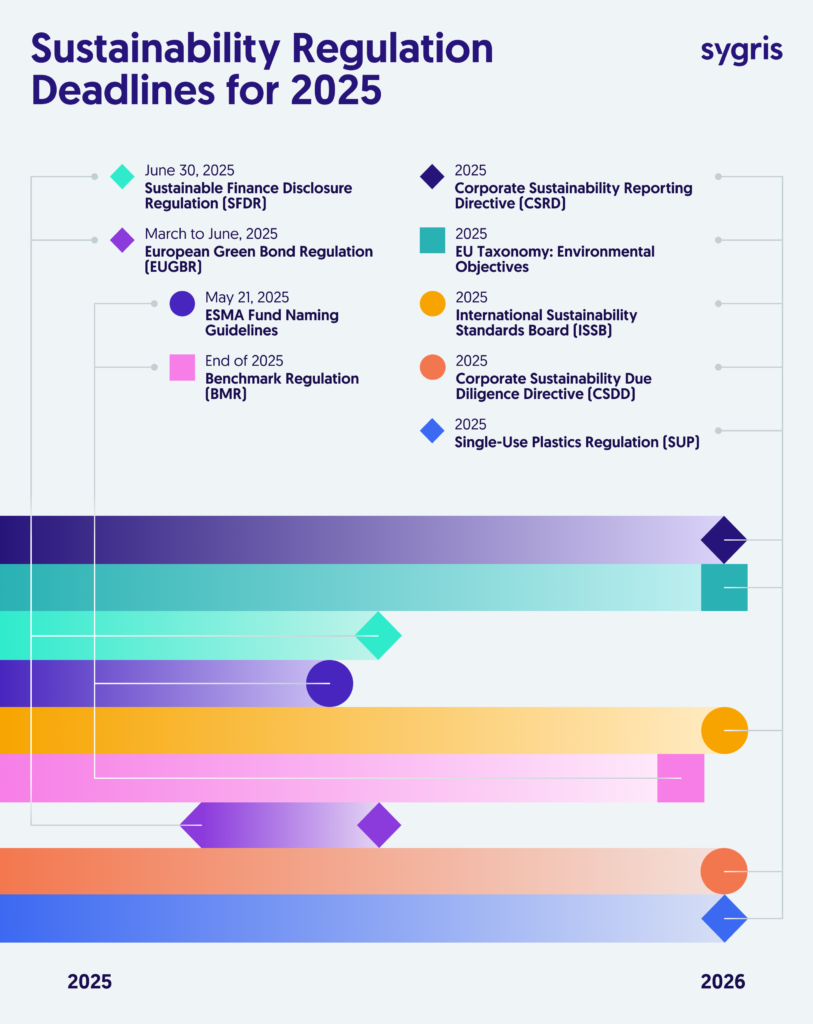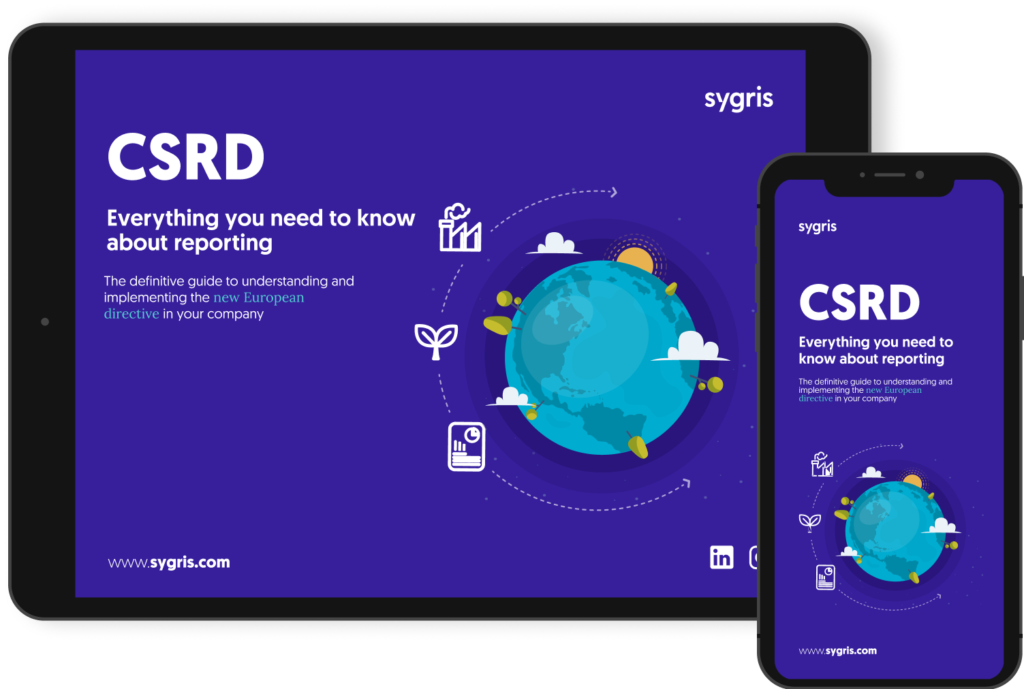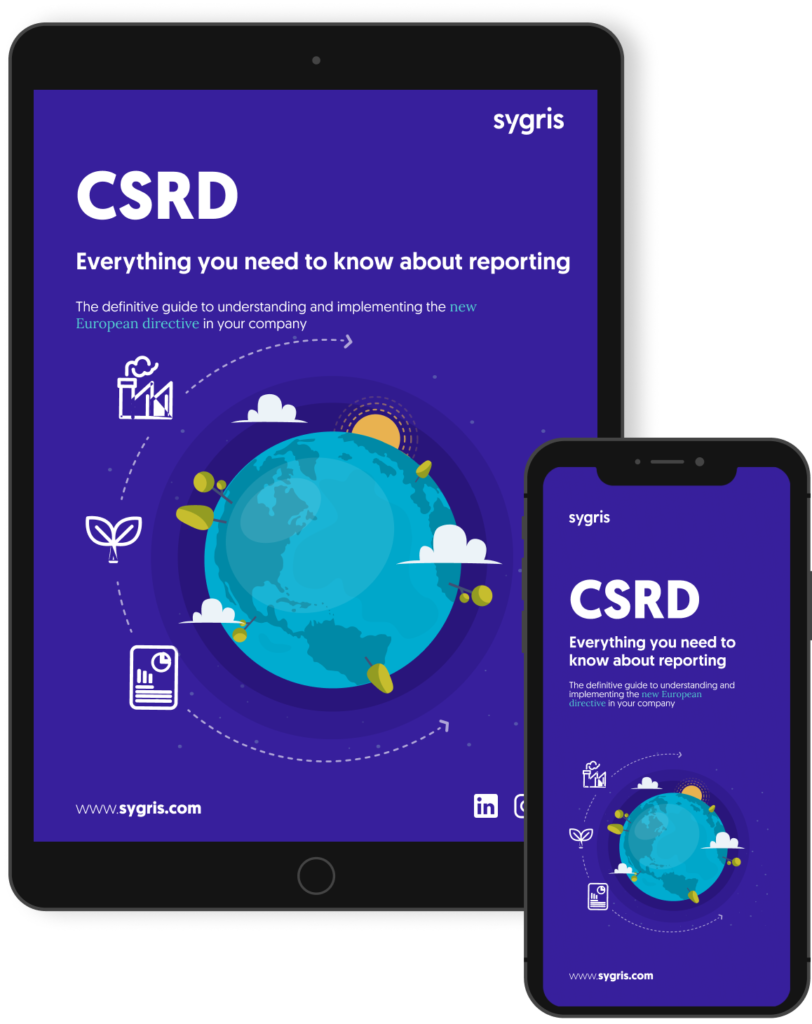The year 2025 is set to be a watershed moment for businesses operating within the sustainability framework. A wave of regulatory deadlines will bring significant changes to corporate transparency and accountability. Key directives such as the CSRD, the EU Taxonomy, and SFDR demand prompt action to ensure compliance. This guide highlights the most important deadlines for 2025, helping companies focus their efforts and prepare for rising regulatory expectations.
1. Corporate Sustainability Reporting Directive (CSRD)
What is it? The CSRD is a European directive that reshapes the way companies report on environmental, social, and governance (ESG) issues. It replaces the Non-Financial Reporting Directive (NFRD), significantly expanding the scope and detail of the required disclosures.
Purpose: To make sustainability reports more transparent, standardised, and comparable, benefitting investors, consumers, and other stakeholders.
Who does it affect?
Large companies that meet at least two of the following criteria:
- More than 250 employees.
- Annual turnover exceeding €50 million.
- Total assets over €25 million.
- EU-listed companies, including SMEs (excluding micro-enterprises).
- Non-EU companies with net turnover above €150 million in the EU and significant operations within the bloc.
What happens in 2025? Companies previously subject to the NFRD must submit their first CSRD-compliant reports for the 2024 financial year. This means data collection began on 1 January 2024, with reporting due in 2025.
Impact: Companies are required to align their reporting with the EU Sustainability Reporting Standards (ESRS), addressing areas such as greenhouse gas emissions, human rights, and governance practices.
2. EU Taxonomy
What is it? The EU Taxonomy is a classification system for sustainable economic activities, covering six key environmental objectives:
- Climate change mitigation.
- Climate change adaptation.
- Sustainable use of water and marine resources.
- Transition to a circular economy.
- Pollution prevention and control.
- Protection and restoration of biodiversity and ecosystems.
Purpose: To guide businesses, investors, and policymakers in identifying activities that contribute to the EU’s environmental and climate goals.
Who does it affect?
- Large companies subject to the CSRD.
- Financial institutions managing investments linked to sustainable activities.
- Companies aiming to demonstrate ESG alignment to investors or stakeholders.
What happens in 2025? Large companies will need to disclose their alignment with all six environmental objectives of the EU Taxonomy for the 2024 reporting period. Financial institutions may also provide estimates on the “Do No Significant Harm” (DNSH) principle and third-country exposures.
Impact: This represents a major step towards transparency in sustainable economic activities, particularly in critical industries like energy, transport, and construction.
3. Sustainable Finance Disclosure Regulation (SFDR)
What is it? The SFDR is an EU regulation aimed at increasing transparency about how financial institutions integrate ESG considerations into their investment decisions.
Purpose: To combat “greenwashing” and ensure investors receive reliable information about the ESG risks and impacts associated with their investments.
Who does it affect?
- Asset managers.
- Investment funds.
- Financial institutions offering investment products in the EU.
Key date: 30 June 2025. Reports on Principal Adverse Impacts (PAI) for the 2024 financial year must be submitted by this deadline. A review of the SFDR Level 1 rules is also expected mid-year.
Impact: Financial institutions will need to assess and disclose the environmental, social, and governance impacts of their investments, strengthening the connection between finance and sustainability.
4. ESMA Fund Naming Guidelines
What is it? Guidelines issued by the European Securities and Markets Authority (ESMA) govern the use of sustainability-related terms (e.g., “green” or “ESG”) in the names of financial products.
Purpose: To ensure that funds using sustainability-focused names meet specific ESG standards, avoiding confusion or misleading claims for investors.
Who does it affect? Investment funds and financial products in the EU that use ESG-related terms in their names.
Key date: 21 May 2025. Existing financial products must comply with ESMA’s fund naming guidelines by this deadline.
Impact: Funds will need to demonstrate compliance with strict ESG criteria before using sustainability-related terms, ensuring greater investor confidence.
5. International Sustainability Standards Board (ISSB)
What is it? The ISSB, created by the IFRS Foundation, develops global ESG reporting standards. Its S1 (general sustainability reporting) and S2 (climate-related risks and opportunities) standards aim to harmonise non-financial disclosures worldwide.
Purpose: To reduce fragmentation across global sustainability frameworks and provide a unified standard for multinational companies.
Who does it affect?
- Global companies operating across multiple jurisdictions.
- Companies seeking to attract international ESG-focused investors.
What happens in 2025? The first companies will begin publishing ISSB-aligned reports for the 2024 financial year.
Impact: These standards are expected to unify global sustainability reporting, reducing inconsistencies between regional frameworks.
6. Benchmark Regulation (BMR)
What is it? The Benchmark Regulation ensures that financial benchmarks used in the EU are robust, reliable, and free from manipulation. It applies to benchmarks used to measure the performance of sustainable funds.
Purpose: To safeguard the integrity and transparency of financial benchmarks, especially those linked to ESG.
Who does it affect?
- Providers of benchmarks used in the EU, including ESG indices.
- Investment funds and financial products relying on these benchmarks.
Key date: End of 2025. The transition period for third-country benchmarks concludes.
Impact: Organisations will need to review and adjust benchmarks to comply with EU standards.
7. European Green Bond Regulation (EUGBR)
What is it? The EUGBR sets a framework for green bonds issued in the EU, ensuring they fund activities aligned with the bloc’s environmental and climate objectives.
Purpose: To promote transparency, credibility, and comparability in the green bond market.
What happens in 2025? A public consultation on outstanding technical standards will take place between March and June, marking a critical step towards finalising comprehensive green bond regulations.
Impact: Issuers of green bonds will need to align with new guidelines to strengthen trust and transparency in sustainable finance.
8. Corporate Sustainability Due Diligence Directive (CSDD)
What is it? A directive from the European Union designed to make companies accountable for identifying, preventing, and addressing the negative impacts of their activities on human rights and the environment throughout their supply chains.
Objective: To encourage businesses to adopt ethical and sustainable practices, enhancing transparency and responsibility in line with the EU’s environmental and social priorities.
What’s happening in 2025? The directive’s requirements will begin to apply, particularly to larger companies operating across borders. This period will also see the development of further guidance and delegated acts to clarify compliance procedures.
Impact: Businesses will need to embed robust due diligence processes into their operations and supply chains, requiring updates to compliance systems and risk management frameworks. While this presents challenges, it also offers a chance to build trust with consumers and investors by demonstrating leadership in sustainability.
9. Single-Use Plastics Regulation (SUP)
What is it? An EU regulation aimed at tackling plastic pollution by reducing the use of single-use plastics, promoting alternatives, and supporting the shift to a circular economy.
Objective: To cut down on plastic waste and protect marine environments by banning or restricting certain single-use plastic products, while encouraging innovation in sustainable materials and recycling practices.
What’s happening in 2025? Stricter rules will come into force, including ambitious targets for reducing plastic use, improving recycling rates, and clearer labelling requirements. Enforcement and compliance checks are also expected to ramp up across member states.
Impact: Businesses will need to innovate and adapt by rethinking product design and investing in sustainable alternatives. Collaboration with partners across the supply chain will be essential to ensure compliance and align with the growing demand for eco-friendly products.
The deadlines of 2025 represent a turning point for corporate sustainability. These regulations not only demand compliance but also offer an opportunity for companies to position themselves as leaders in sustainability. Understanding the requirements, planning ahead, and acting strategically will be key to navigating this new landscape.





